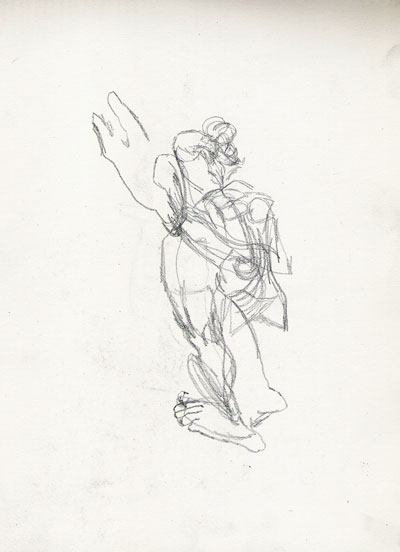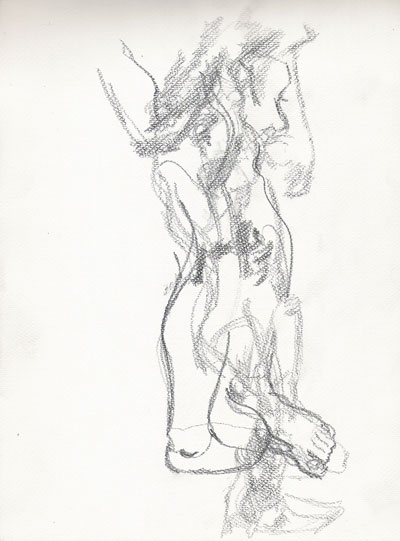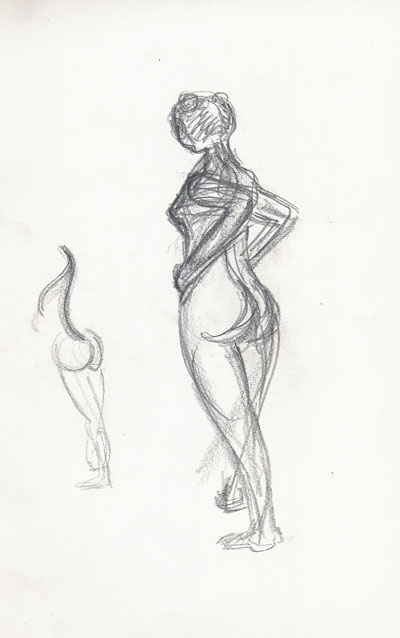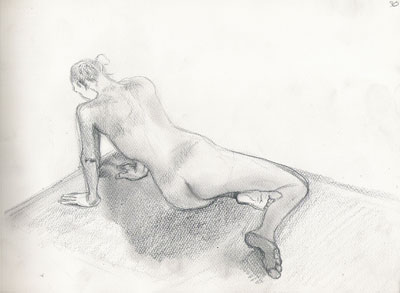
So last Monday evening (the 21st) I attended the first session of the Autumn Life Drawing Term at The Prince's Drawing School. I meant to post these drawings last week but my schedule's been so manic it just never happened. Luckily you've had cat-like shapes to look at on this blog, so I don't feel so bad. :) But considering I attended my second session last night, I figured I'd better start blogging about them pronto.
The drawing up there is the first one I did that first evening, a 10 minute pose. In general conversation I find it kinda hard to describe what drawing means to me, and specifically why I rate life drawing so much. So this term I'm going to try and share my experience of the class as much as possible on this blog. For several terms now I've shared my drawings but only occassionally gone into describing the experience.
Our tutor Charlotte Mann took us through various exercises that really helped highlight the process of drawing as a highly active, mentally engaging and physically immersive experience.
The first exercise we explored was drawing blind. This involved restricting ourselves to only looking at the model while we drew, never once looking down at the pad/easel. What this does is focuss you on truly observing your subject and making marks that can only be in response to exactly what you observe. Without the drawing itself to get feedback from as you work, you get a sense of what it means to make those observations count.
Drawing blind gives you something like this:

All the marks here feel true to me. There's also clearly evidence of the figure here - obviously conventional form is a separate matter.
We then did a couple of drawings from memory. Essentially the opposite of drawing blind, we observed the model for several minutes, then drew what we could recall:

thus highlighting the importance of storing what we observe and how unreliable our memory of something can be. Sounds obvious, but it's amazing how often we default to a pre-conceived idea of how, say, a thigh should look as opposed to how that model's thigh really looks.

The cool thing is that drawing from memory is something you can rapidly improve on. Just observe and record whenever possible. Always carry a sketchbook.
Here's the next thing we did:

drawn blind as you probably guessed.
Then another from memory:

And then we drew for 16 minutes, switiching between drawing blind and from memory every 2 minutes or so:

This was fun because I got a real sense of obervation and memory doing the Tango inside my head as I drew...
We finished up with this 30 minute pose:

Those earlier exercises really make you aware of your drawing process. Despite the therapeutic qualities of the act of drawing and the almost trance-like state it often puts me in, drawing is an activity that I really have to get involved in - meaning there's nothing passive about it.
Without meaning to sound esoteric, it's almost like there's me, there's the subject and there's my drawing. While all 3 are equally active participants in the process, that process is the reason I draw and not the components or end result. To not engage is to not draw.
I'll have some stuff up from Session 2 soon.

No comments:
Post a Comment